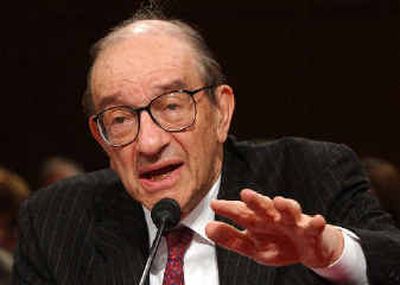Fed poised to bump up rates

WASHINGTON — Ready to raise interest rates for the first time in four years, the Federal Reserve on Tuesday began debating how fast and how high. But one issue wasn’t in doubt — the man controlling the debate was still Alan Greenspan.
Greenspan’s command as Fed chairman is showing no signs of waning even though he now is officially a lame duck, having been sworn in this month for a fifth and last term. It was acknowledged during his confirmation hearing that he plans to serve only 19 months of his four-year term as chairman, choosing to step down on Jan. 31, 2006, when his 14-year regular board term comes to an end.
“There is not the slightest indication that Alan Greenspan is going to behave like a lame duck although technically he is one,” said economist David Jones, the author of several books on the Greenspan Fed and chairman of Investors Security Trust Co. of Fort Myers, Fla.
Economists are convinced that the Federal Open Market Committee will vote today in favor of a quarter-point increase in the federal funds rate, the interest that banks charge on overnight loans and a strong influence on other rates Americans pay. The federal funds rate is now at a 46-year low of 1 percent.
This week’s increase, analysts believe, will be followed by others in the coming months in an effort to keep inflation in check, although there is dispute over just how fast and how high the Fed will want to push rates, especially in an election year.
Greenspan is able to lead, Jones and other economists believe, because of his skill in managing the economy — 17 years at the Fed with just two brief recessions — and his ability to meld a consensus on the 19-member FOMC, the panel of seven Fed board members and 12 regional bank presidents who meet eight times a year to set interest rates.
“It’s not a situation where an imperial chairman dictates and the rest follow,” said Sung Won Sohn, chief economist at Wells Fargo in Minneapolis. “His track record plus his painstaking solicitation of views from other members leads to consensus.”
None of the other board members comes close to matching his longevity at the Fed. Greenspan was first appointed by Ronald Reagan in 1987.
The next-longest-serving Fed board members — Vice Chairman Roger Ferguson and Edward Gramlich — were appointed in 1997 by Bill Clinton. The other four Fed board members were all appointed in the past three years.
In that group, Ben Bernanke, one of the country’s leading economists on monetary matters while a professor at Princeton, has staked out a position that normally hews close to the views of Greenspan. The same can be said of the speeches of Donald Kohn, a longtime Greenspan confidant on the Fed staff who was elevated to the board two years ago.
One of the Fed’s 12 regional bank presidents, William Poole of St. Louis, has come the closest to breaking from the mainstream view that inflation is not a problem. However, none of the regional presidents — five of whom have voting privileges in any one year — are expected to be so bold as to voice a dissent when the Fed announces its latest decision.
Dissents have been few during the Greenspan era. Two members did vote in September 2002 to lower rates immediately while the majority favored holding them steady.
The Fed’s last change came on June 25, 2003, when it lowered the federal funds rate by a quarter-point. That pushed banks’ prime lending rate, the benchmark for millions of consumer and business loans, down to 4 percent, a level not seen since Dwight Eisenhower was president in 1959.
Many analysts believe that after today the Fed will continue small increases the rest of the year and into next year, not stopping until it has raised the funds rate to around 4 percent.
The chairman is expected to be cautious in increasing rates too quickly in order to avoid one of the rare blunders of the Greenspan years — a string of increases in 1994 that caught financial markets by surprise following a long period of low rates. The subsequent financial turmoil contributed to the Mexican peso crisis and the bankruptcy of Orange County, Calif.
“Chairman Greenspan wants to leave on a high note, and for him to leave on a high note he can’t be overly aggressive,” said Diane Swonk, chief economist at Bank One in Chicago. “He wants to secure his legacy.”